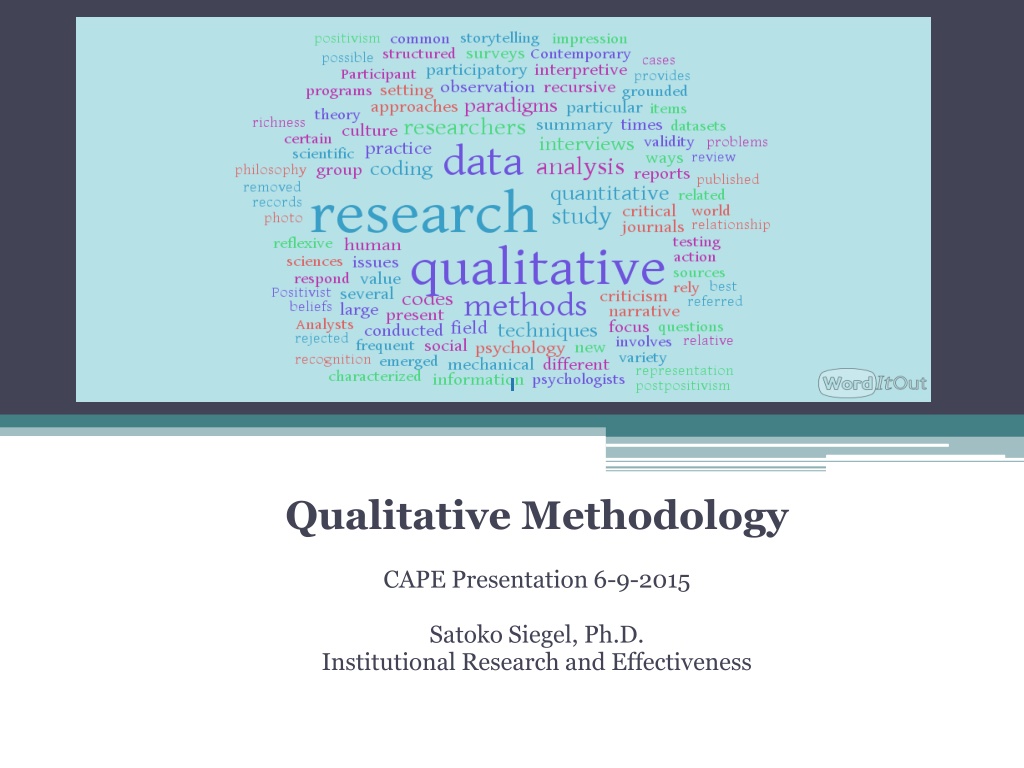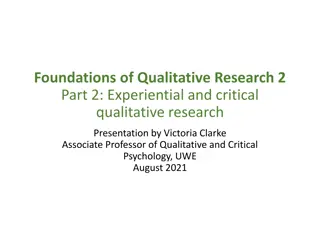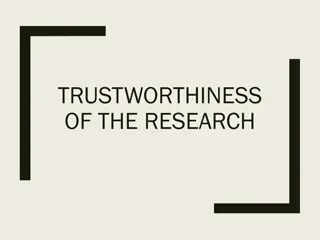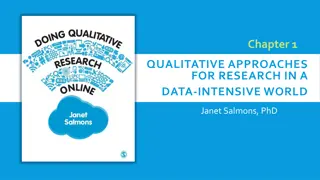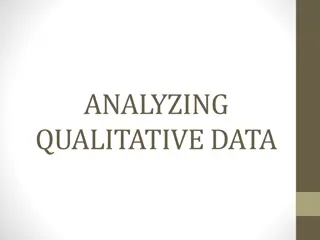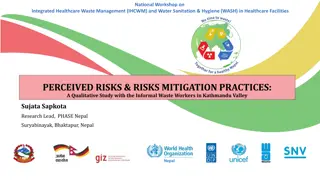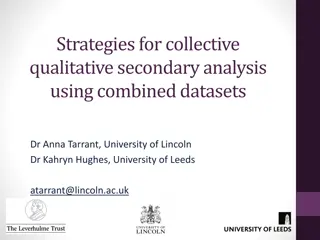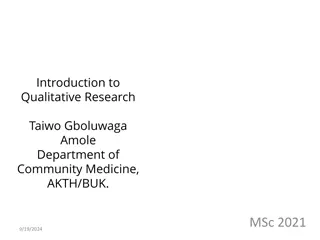Understanding Qualitative Methodology: An Overview
This presentation delves into the realm of qualitative methodology, exploring its purpose, characteristics, approaches, data collection methods, analysis, and learning outcomes. It aims to provide a deep understanding of how qualitative research illuminates voices and experiences, distinguishes between qualitative and quantitative methods, and analyzes data for holistic descriptions. Through examples and discussions, participants will gain insights into various qualitative approaches and the intricacies of interpreting collected data.
Download Presentation

Please find below an Image/Link to download the presentation.
The content on the website is provided AS IS for your information and personal use only. It may not be sold, licensed, or shared on other websites without obtaining consent from the author. Download presentation by click this link. If you encounter any issues during the download, it is possible that the publisher has removed the file from their server.
E N D
Presentation Transcript
Qualitative Methodology CAPE Presentation 6-9-2015 Satoko Siegel, Ph.D. Institutional Research and Effectiveness
Presentation Outline What is Qualitative Methodology? Purpose Characteristics Qualitative and Quantitative Basic differences Qualitative Approaches Case Study Ethnography Phenomenology Grounded Theory
Presentation Outline Contd Data Collection Methods Observation Interview Document analysis Analysis Results & Discussion Example: Qualitative Study in Healthcare Limitation Exercises
Presentation Learning Outcomes At the completion of this presentation, participants will be able to: 1. Understand the purpose and characteristics of qualitative methodology. 2. Recognize differences between qualitative and quantitative methodology. 3. Provide examples of different types of qualitative approaches and data sources. 4. Understand how to analyze and interpret data collected through qualitative approaches.
What is Qualitative Methodology? Purpose To illuminate voices To gain in-depth understanding of people s lived experiences and insights: Why How & What is going on? To provide holistic, deep and rich description
General Characteristics 1. A Descriptive and Exploratory Focus Rich descriptions and understandings of people s experiences in a given context and under certain conditions (e.g.) values, opinions, behaviors and social contexts of particular populations http://cdn.themetapicture.com/media/funny-cartoon-perspective-cast-away-island.jpg 2. An Emergent Design Area of study/idea/questions Data collection
3. A Purposive Sample A few individuals A single setting (e.g.) a particular classroom, school http://about.brighton.ac.uk/pabsstudyskills/img/main-images/main-images/field%20trip2.JPG 4. Natural Setting A researcher visit a field. 5. Researcher as a Primary Tool A collector and an analyzer of the data Reflexivity Emic/Etic datahttp://about.brighton.ac.uk/pabsstudyskills/essential-skills/field-trip-reports.html
6. Data as Peoples Words and Actions To capture the language and behavior of the participants. 7. Ongoing, Inductive Data Analysis Look for patterns, themes, overarching ideas Area of study/idea/questions Data collection Theory/previous study On-going analysis 8. Narrative Reporting of the Research Outcomes Rich/thick description
Qualitative and Quantitative Qualitative methodology A study of words and meaning Seeks to understand why people practice certain behaviors Data are words. Quantitative methodology Study of numbers Asks how many people practice certain behaviors Aims to find numerical patterns in data
Q: How much do you drink coffee? http://sheilapontis.files.wordpress.com/2014/05/133-content.jpg?w=710h=293 https://sheilapontis.wordpress.com/2014/05/27/information-design-content/
Basic Differences between Qualitative and Quantitative Methodologies Qualitative Quantitative Develop sensitizing concepts, describe multiple realities, generate grounded theory, develop understanding Test theory, establish facts, generate statistical description, show relationships between variables, predict Goals Evolving, flexible, open-minded Structured, predetermined, formal, specific Designs Generally small, theoretical sampling, purposeful Large, stratified, random selection Sample Observation, open-ended interview, documents Experiments, survey research, quasi- experiments, structured interview and observation Methods Empathy, trust, intense contact Detachment, short-term, distant, subject-researcher Relationship Ongoing, themes, concepts, inductive, constant comparative Deductive, occurs at conclusion of data collection, statistical Data Analysis Bogdan and Biklen (2007)
Qualitative Approaches 1) Case Study 2) Ethnography 3) Phenomenology 4) Grounded Theory Purpose Research Question
1) Case Study Purpose To gain a deep understanding of a single person or a group, or a specific instance of the phenomenon at a specific time In-depth study Research Question In this particular setting, why ? In this particular case, how .?
2) Ethnography Purpose Learning (experiencing) the culture of the group and describing their way of life in a natural setting Understanding sense-making process of the culture Research Questions What is going on in the field? What is the way of life there? http://www.antropologi.info/blog/cicilie/2006/ethnography_as_the_inscription_of_partic
3) Phenomenology Purpose To understand and describe the lived experiences of people who have experienced a phenomenon or been exposed to a certain set of conditions. Research Question What are the people s experiences? How have they experienced it? How have they made sense on various effects related to the phenomenon?
4) Grounded Theory Purpose To develop a theory about phenomena of interest. Theory needs to be grounded or rooted. A theory is related to some aspects of social life. Research Question How can we explain this phenomenon of interest?
Qualitative Data Collection Methods 1. Observation To provide detailed notation of behaviors and events, and the contexts surrounding them. 2. Interview (individual, focus group) To collect data about an individual s experience and knowledge, opinions, beliefs and feelings as well as demographic data. 3. Document/product analysis To collect data through documents/products (e.g.) portfolios essays
1) Observation Capturing: The context in which participants interact Things that participants are unwilling or unable to talk about. Things that participants are not aware of. Holistic understanding of the phenomena Direct connections between researcher and the people
Participant observation Passive participation Moderate participation Active participation Complete participation http://2.bp.blogspot.com/-_uD4GyWNhtM/T1_B8CUSNgI/AAAAAAAABCI/f9AMLPGvJnI/s1600/eval.png Observation Descriptive observation Focused observation Selective observation Field notes http://teachingmyfriends.blogspot.com/2012/03/teacher-observations.html
2) Interviews Informal interviews Casual conversation With participant observation in the field Formal interviews Scheduled time and place
Interview approaches Unstructured Clear plan, focus and goal Open-ended Discussion http://api.ning.com/files/VMnGwLNwu9b2uBy*rKcQQG1E7pJaykJDcjWUlVKfdWIr3WPfG72WI*a3mgn9DBg5NJ9z2oLD*y*iLSzaVaxEH90GGA1Q7oUt/interview.jpg Semi-structured Interview guide (topics) Pre-planned Open-ended Structured Same series of questions All pre-planned Closed-ended Audio recorded transcript.
Styles Individual interview (in-depth interview) To discover phenomena that cannot be directly observed or obtained through documents. Focus group (6-10 people) A semi-structured group interview process Moderated by a facilitator A specific topic
Focus group Interactions among participants Racial/ethnic minority students To explore new research areas To explore a topic that is difficult to observe To gather preliminary data to develop surveys and interview guides Limitation Socially desirable answers Majority vs. Minority
3) Document/Product Analysis Integrated method, procedure and technique for locating, identifying, retrieving and analyzing documents. symbolic representation and meaning Quantitative -- counting the number of times that a theme occurs Qualitative -- identifying the major themes
Purpose Background information Historical insights Identify information needs to be asked/observed Supplementary research data A means of tracking change and development Verify findings or evidence from other sources
Qualitative Analysis Thematic analysis Classify information into categories Seeking commonalities On-going, inductive Data collection and analysis occurs at the same time.
Interviews Transcribing Documents/Products Reading/selecting Observation Field notes Data Collection Coding Analyzing Data Thematic Categories Interpreting the data literature Result Reporting
Qualitative Results & Discussion Theme Categories Direct quotations from interviews and focus groups The best representation of the theme Vivid illustrations Connection to literature Previous studies Theories
Example: Qualitative Study in Healthcare Benoot, C., Bilsen, J., Grypdonck, M., and Deschepper, R. (2014). Living alone during cancer treatment: an exploration of patients experiences. Qualitative Health Research, 24, 1057-1067. Purpose: to understand the experiences of cancer patients living alone Methodology: qualitative (grounded theory) Participants: 32 cancer participants (26 women, 6 men) Data collection: in-depth interviews with a loosely structured interview guide; audiotaped and transcribed Analysis: thematic coding, similarities, differences, re-occurring perspectives, comments etc.
Result: How cancer patients experienced live alone Living alone experienced as a lack I do have a good son. He always says I can call him any time of the day or night if something is wrong, but I don t want to do that. He s human too, isn t he? He has his own life. Living alone experienced as a treat to their adjustment to cancer When I came out [of the doctor s office] with the bad news, you re there on your own, and then you even have to get the bus home, and then you have to change buses and it s a really long way, honestly. I came to the conclusion that you do really need someone with you, otherwise it s all just too much.
Living alone experienced as a gain I do whatever I want, don t I? I watch TV when I want to watch TV, I go to sleep when I want to go to sleep, I eat this or that depending on what I feel like. If I don t have an appetite, I just don t eat. If I only want soup, I have soup. If I want to go to a restaurant I go to a restaurant. I don t have to think about anyone else. Conditions for the experience of living alone --- depending on the history of living alone. Now they are telling me I have to be an optimist and put up a strong fight against cancer, and maybe I do want to but I don t always manage it. Look, my husband is dead now. I was married for fifty-six years, you see, and that is a strong connection, isn t it?
Staying independent as a key goal during cancer treatment Staying independent out of necessity So I hope there won t be many side effects, and I think that goes for everyone, but I reckon it especially important for me because I live alone. So for me it really is very important that I can keep my independence. I am alone and I have to stay able to keep my house up. I still need to get it completely renovated, I have to be able to manage the gardening. Nobody can just do it for me. Staying independent as a matter of dignity. That s very important, of course. If I don t have my independence then I m no longer myself. It s so bad I don t even want to go for dinner with the kids. Bad, isn t it? Other people laugh at me but it s important to me, my dignity.
Continuity or discontinuity of the experience of living alone So I was feeling that actually I was going to have to manage on my own, and I worried about it. But I did manage after all, for the first two weeks. I felt really strong then. If I ve got through that I can deal with anything. I think I can probably manage my whole treatment because I was strong on my own.
Discussion: Previous studies Clark and Mils (1993): An absence of A communal Relationship Klinenberg (2012): Living alone by choice Michael, Berkman, Colditz and Kawachi (2001): Older women living alone Implication: Health care providers should recognize: What the meaning of living alone is for patients can only be recognized by asking the person in question how it is for him or her to have cancer while living alone. The need for independence as an important component of living alone, and as a major goal during cancer treatment
Ways to use qualitative approaches Mixed method (Qualitative & Quantitative) Qualitative methods have been used To develop survey and questionnaires. To explore quantitative findings with participant s voices. Triangulation Data sources Documents, interviews etc. approaches (e.g.) focus group observation (coding) focus group
Limitations Generalizability Not looking for generalizability transformability Factual error The researcher misrepresents the participants' comments/perspectives member checking Interpretation error The researcher misinterprets the data and draws an inaccurate conclusion peer reviewers
Limitations Contd Time-consuming Transcribing Analyzing
Exercises Scenario 1 : The result of your department Graduating Student Survey shows that only 30% of the students agreed that Working in teams enabled me to learn from my peers . Information You were told to figure out why the result came out as they did. You do not have time to interview individual students. You do not have an access to classroom group work sessions. Approach? case study, ethnography, phenomenology, grounded theory Data Collection Method? Observation, interviews, product/document analysis
Exercises Scenario 2 : You are interested in how student clubs impact students academic success. Information WASC wants to know. You have access to the student club. Your students club has an activity or meeting once a month. You know students who are in the student club. Approach? case study, ethnography, phenomenology, grounded theory Data Collection Method? Observation, interviews, product/document analysis
For questions and/or more information, please contact Satoko Siegel (ssiegel@westernu.edu). THANK YOU SO MUCH!
